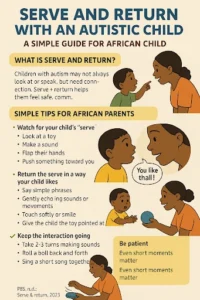Author's details
- Dr. Khashau Eleburuike
- MBBS (Ilorin) MSc. Global Health Karolinska Institute.
- Resident doctor in family medicine in Northern Sweden.
Reviewer's details
- Dr Kikelomo Babata
- MBBS(Ilorin), Paediatrician and Neonatologist. Assistant Professor at University of Texas Southwestern Medical Center
- University of Texas Southwestern Medical CenterDallas, Texas USA

- Date Published: 2025-06-14
- Date Updated: 2025-06-14
Parenting the Autistic Child
Autism Spectrum Disorder (ASD), commonly referred to as autism, is a developmental condition that affects how a person communicates, interacts with others, and experiences the world. While awareness of autism is growing globally, many families in Sub-Saharan Africa still face stigma, lack of access to information, and inadequate support. This guide aims to provide culturally sensitive information and practical tips for African parents, caregivers, siblings, and communities to support autistic children with compassion, dignity, and understanding.
What is Autism?
Autism is a neurodevelopmental disorder characterized by:
- Social communication challenges (difficulty understanding social cues, initiating or sustaining conversations).
- Repetitive behaviors or interests (repeating actions, having a strong focus on certain topics).
- Sensory sensitivities (over- or under-reacting to sound, touch, light, or smells).
Autism is a spectrum, meaning that each child is unique. Some may be nonverbal and require significant support, while others may be highly verbal and independent but struggle with social connections.
Key facts:
- Autism appears in early childhood, usually before age 3.
- It affects boys more often than girls.
- It is not caused by bad parenting, evil spirits, or vaccinations.
- Early intervention and support improve long-term outcomes.
Understanding Autism in the Sub-Saharan African Context
In many African cultures, children with disabilities are often misunderstood or hidden due to stigma, traditional beliefs, or spiritual interpretations. Common myths include:
- Believing the child is bewitched.
- Thinking of the child is a punishment or curse.
- Assuming the child will “grow out of it.”
These misconceptions hinder timely diagnosis and support. It’s important to understand that autism is a medical and developmental condition, not a spiritual or moral failing.
Supporting the Autistic Child: Parenting Tips
- Acceptance and Understanding
- Love your child unconditionally. Accept who they are rather than who society expects them to be.
- Learn about autism. The more you understand, the better you can advocate and provide the right support.
- Create Structure and Routine
- Autistic children thrive on predictability. Daily routines help them feel secure.
- Use visual schedules, simple rules, or songs to explain steps in a routine.
- Support Communication
- If your child is nonverbal, use alternative methods like sign language, pictures, or communication apps.
- Have eye contact by using for example serve and return.
- Be patient. Give them time to respond and express themselves.
- Have a daily routine of reading aloud and talking with them.
- Manage Sensory Needs
- Notice what triggers distress (loud sounds, scratchy clothes, bright lights).
- Create a calm space at home where the child can feel safe.
- Limit screen time among autistic children.
- Encourage Strengths and Interests
- Many autistic children have special talents (drawing, memory, music, patterns).
- Encouraging activities they enjoy can boost confidence and provide learning opportunities.
- Seek Professional Help
- If possible, consult with a pediatrician, speech therapist, or psychologist with autism experience.
- Community health workers or trained teachers can often offer support in areas with limited specialists.
Tips for Adults in the Family and Community
- Be patient and non-judgmental. Avoid punishing behaviors you don’t understand.
- Speak respectfully. Use positive language when referring to the child.
- Include them. Don’t exclude autistic children from family or community events. Make adaptations instead.
- Challenge stigma. Educate others with love and facts when you hear misinformation.
Tips for Siblings
Growing up with an autistic brother or sister can be challenging but also deeply rewarding. Help siblings:
- Understand that their sibling’s brain works differently, but they still have feelings and needs.
- Express their feelings in healthy ways—through conversation, drawing, or journaling.
- Spend one-on-one time with parents so they don’t feel left out.
- Celebrate their sibling’s progress and strengths.
Adapting African Parenting Values
African parenting emphasizes community, respect, obedience, and interdependence. These values can be powerful when adapted to supporting autistic children:
| African Value | Adapted Approach for Autism |
|---|---|
| Respect | Teach respect through modeling, not fear or punishment. Autistic children may need time to learn social rules. |
| Obedience | Focus on understanding and safety rather than blind obedience. Use gentle guidance. |
| Community Support | Involve extended family and neighbors in care. Educate them about autism to reduce isolation. |
| Storytelling | Use stories or proverbs to teach social and emotional skills. |
Serve and Return with an Autistic Child: A Simple Guide for African Parents
What is Serve and Return?
Serve and return is like playing a game of catch with words, actions, or looks. Your child “serves” by doing something—like pointing, making a sound, or looking at something. You “return” by responding with words, touch, or actions. This helps your child’s brain grow strong.
Why is it important for an autistic child?
Children with autism may not always look at you, speak, or respond the way other children do. But they still need a connection. Serve and return helps them feel safe, learn to communicate, and build their thinking and social skills—even without words.
Simple Tips for African Parents Figure 1
✅ Watch for your child's “serve”
Your child may not speak, but they might:
- Look at a toy
- Make a sound
- Flap their hands
- Push something toward you
✅ Return the serve in a way your child likes
- Say something simple: “You like the ball!”
- Copy their sound or movement (echo it gently)
- Touch them softly or smile
- Give them the toy they pointed at
✅ Keep the interaction going
Even if it’s just 2–3 turns:
- Take turns making sounds
- Roll a ball back and forth
- Sing a short song together
✅ Follow your child’s lead
Let your child choose what they want to do. If they are spinning a lid, sit with them and join in. That builds trust.
✅ Be patient
Your child may not respond right away. Wait a little, then try again later. Even short moments matter.
Important Reminders
- No need for perfect grammar or English—speak in your local language.
- Use daily moments like bathing, cooking, or walking to connect.
- You do not need expensive toys, use spoons, bottles, balls, or hands.
Example
Your child touches a cup (serve).
You say: “Cup! You want water?” and give them a little water (return).
They smile or drink (serve).
You smile back and say: “Good drinking!” (return).
That is serve and return!
Figure 1 Serve and Return for an Autistic Child

Parenting an autistic child in Sub-Saharan Africa comes with unique challenges, but also great opportunities. With love, patience, and informed support, autistic children can live meaningful and fulfilling lives. Breaking the silence, challenging stigmas, and embracing neurodiversity will lead to stronger families and communities.
- World Health Organization. (2023). Autism spectrum disorders. https://www.who.int/news-room/fact-sheets/detail/autism-spectrum-disorders
- American Psychiatric Association. (2022). Diagnostic and Statistical Manual of Mental Disorders (DSM-5-TR).
- Olusanya, B. O. et al. (2021). “Disability and Child Development in Sub-Saharan Africa.” The Lancet Child & Adolescent Health.
- Oti-Boadi, M. (2017). “Exploring the Lived Experiences of Mothers of Children with Autism in Ghana.” Journal of Autism and Developmental Disorders.
- United Nations. (2021). The rights of persons with disabilities. https://www.un.org/development/desa/disabilities/
- Autism Speaks. (2024). Toolkits and Family Support. https://www.autismspeaks.org
- Harvard University Center on the Developing Child. (2021). Serve and Return Interaction Shapes Brain Architecture. https://developingchild.harvard.edu
- Autism Speaks. (2023). Tips for Communicating with Your Nonverbal Child. https://www.autismspeaks.org
- World Health Organization. (2023). Parent Skills Training for Caregivers of Children with Developmental Disorders.
